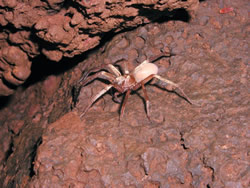Protecting the elusive, cave-dwelling troglobites
“Who will speak for the imperiled troglobites? Charismatic megafauna, they are not. Troglobites—not to be confused with troglodytes (cavemen) or trilobites (extinct arthropods)—are neither warm-blooded nor fuzzy. Most are invertebrates, including insects and crustaceans, but there are also troglobitic fish and amphibians—and all are as weird as they are rare.”
That’s how Katherine Ellison starts her article in the April issue of Frontiers in Ecology and the Environment. And it’s something to think about. Fields like conservation psychology have emerged as a way to encourage the public to support environmental and wildlife conservation efforts. For example, teaching children to identify native birds could lead to a community’s long term appreciation for the role these birds have on the local ecosystem.
But as Ellison points out about troglobites, these (usually) pigmentless, exclusively cave-dwelling creatures “have lived for millennia out of sight and out of mind.” They do not flaunt colorful plumage or sing elaborate tunes; they do not have large, child-like eyes (or in many cases, any eyes at all) or engage in human-like behaviors such as tool usage (at least, none of the more than 7,500 troglobitic species that have been discovered). Therefore, they are not what the public would think of as “cute.”
Research has shown that people are more likely to support the protection of an animal if it is deemed attractive, especially if it is also human-like in appearance or behavior. But even the most human-like of troglobites—the Proteus anguinus, a blind salamander also known as an olm or human fish that lives in the caves of Slovenia—is on the endangered species list (see below video).
However, while these rare species do not fall into the “cute” category, scientists and science fiction writers alike can be inspired by their unique characteristics—like the misunderstood olm, which was first described in the 1600s as a baby dragon. Or the endangered Kaua’i cave wolf spider, which, unlike its surface-dwelling relatives, is completely eyeless, yet it tracks down amphipods without the use of a web; it lives in lava tubes in Kauai’s Koloa Basin and is completely harmless to humans. Then there are the crayfish Orconectes australis from Alabama caves that can live up to 175 years and reproduce for 100 of those years, and the giant troglobitic centipede that catches cave bats in mid-flight and devours them whole (see below).
Troglobites are just one of many examples of life in unlikely places, and they can serve as the mascot for researching and preserving all of Earth’s curious corners. As Ellison says, “Troglobites are famous for their patience. They have extraordinarily slow metabolisms—some can survive for years without eating and some live longer than humans. The big question, of course, is whether they can persist long enough for us humans to learn to appreciate their hidden charms.”
So who is protecting these troglobites and their habitats? Recently, karst conservation groups have been springing up in an effort to preserve karst areas and their fragile ecosystems. Karst describes terrain largely formed by underground drainage and through the dissolution of layers of bedrock, such as in the formation of caves and sinkholes. The Karst Waters Institute, for example, aims to research and improve karst water resources—karst aquifers, like Florida’s freshwater springs, supply large amounts of drinking water to the state. Since troglobites are exclusively cave-dwelling, karst conservation will hopefully benefit them as well.
As Ellison points out, though, these rare creatures and their habitats are largely overlooked by larger conservation groups and the public, despite their close tie to environmental health:
[S]tuck in one small place as they are, troglobites are super-sensitive and telling signposts for the health of a given environment. Many absorb pollutants such as pesticides and sewage, suffer inordinately from droughts, and are defenseless against invasive species. The threats to troglobites may not be as obvious or as dramatic as those faced by pandas and tigers—no one hunts them for their pelts or ships them off to zoos to be admired. Yet considering what they portend for our own species, [including the quality of drinking water,] we should probably be paying them more attention.
Read more and see photos in National Geographic’s “Discoveries in the Dark.”
Katherine Ellison (2010). An underground movement Frontiers in Ecology and the Environment, 8 (3), 168-168
Gunnthorsdottir, A. (2001). Physical Attractiveness of an Animal Species as a Decision Factor for its Preservation Anthrozoos: A Multidisciplinary Journal of The Interactions of People & Animals, 14 (4), 204-215 DOI: 10.2752/089279301786999355
